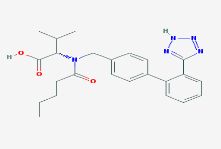Valsartan Is An Orally Active Nonpeptide Triazole-derived Antagonist Of Angiotensin (At) Ii With Antihypertensive Properties. Valsartan Selectively And Competitively Blocks The Binding Of Angiotensin Ii To The At1 Subtype Receptor In Vascular Smooth Muscle And The Adrenal Gland, Preventing At Ii-mediated Vasoconstriction, Aldosterone Synthesis And Secretion And Renal Reabsorption Of Sodium And Resulting In Vasodilation, Increased Excretion Of Sodium And Water, A Reduction In Plasma Volume And A Reduction In Blood Pressure. There Is Contradictory Evidence With Regard To Treating People With Heart Failure With A Combination Of An Angiotensin Receptor Blocker Like Valsartan And An Angiotensin-converting Enzyme Inhibitor, With Two Major Clinical Trials (Charm-additive & Valheft) Showing A Reduction In Death, And Two Others (Valiant And Ontarget) Showing No Benefits, And More Adverse Effects Including Heart Attacks.
Details
Molecular Structure
